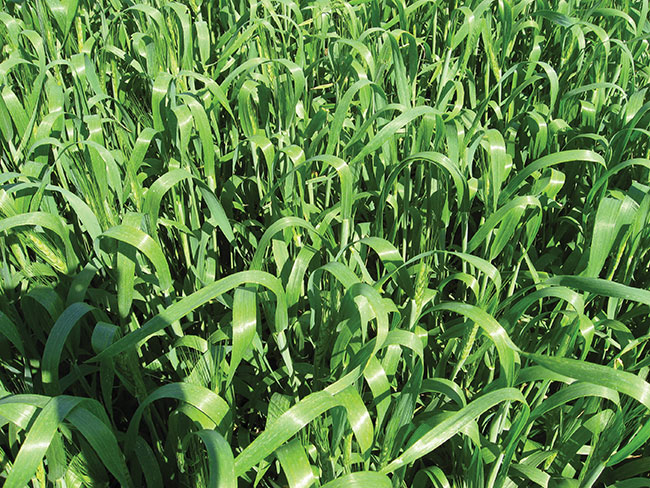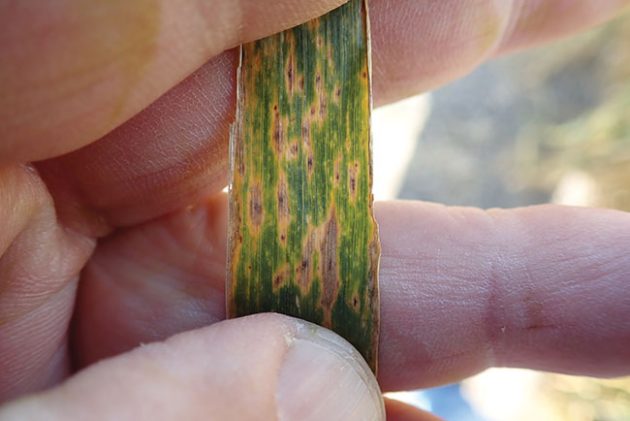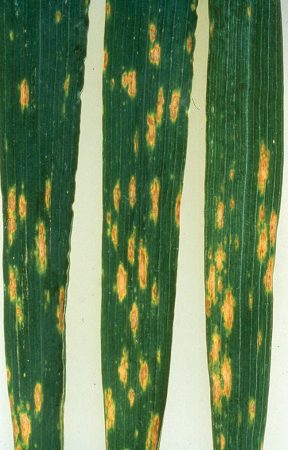
Features
Agronomy
Diseases
Foliar fungicides target flag or anthesis timing in spring wheat
Optimum timing depends on leaf spot and Fusarium head blight pressure, but early foliar fungicide applications are ineffective.
June 27, 2022 By Bruce Barker
 For the most effective control of tan spot in wheat, target the flag to early anthesis stage.
Photo courtesy of Randy Kutcher.
For the most effective control of tan spot in wheat, target the flag to early anthesis stage.
Photo courtesy of Randy Kutcher.
Why not throw in some foliar fungicide for leaf disease control when applying herbicides or apply in a tank-mix with a plant growth regulator (PGR)? That’s been a question commonly asked – and acted on – by some producers for some years. But is the practice justified? When is the right timing for a foliar fungicide application for leaf spot disease, and how does that match up with Fusarium head blight (FHB) control? Those are some of the questions Sheri Strydhorst, agronomy research specialist with Alberta Wheat and Barley, recently set out to answer with research conducted in Alberta.
“There was some previous research that showed flag leaf timing was best for foliar disease control in spring wheat, but there is always talk that the new varieties have improved disease resistance,” Strydhorst says. “From a producer’s perspective, it is good to be able to prove that those recommendations are still valid.”
Additionally, there have been anecdotal reports of producers tank-mixing fungicides with herbicides, or with PGRs at early stem elongation in an attempt to control foliar diseases – arguably to reduce application costs and the number of trips across a field.
Strydhorst’s research was conducted at sites in Barrhead, Bon Accord, Red Deer, and an irrigated site in Lethbridge in 2018 and 2019.
AAC Brandon and AAC Viewfield, both CWRS varieties, were grown in each year. AAC Brandon is resistant to leaf rust and stem rust, moderately resistant to stripe rust and FHB, and has intermediate resistance to leaf spot. AAC Viewfield is resistant to stem and stripe rust, has moderate resistance to leaf rust and common bunt, and intermediate resistance to leaf spots and FHB.
The objective of the study was to determine the effects of foliar fungicide application timings on leaf spot disease severity, yield, quality and economics of these two large-acre CWRS (Canada Western Red Spring) wheat varieties, as well as provide up-to-date fungicide timing recommendations to producers and agronomists.
Four single-fungicide application timings were compared, and included a non-treated control. At the herbicide timing of BBCH 22-23, Tilt 250E (propiconazole) and Trivapro A+B (azoxystrobin, propiconazole and benzovindiflupyr) were compared. These fungicides are registered to control Septoria leaf spot and tan spot at this growth stage. The Tilt rate applied was the registered rate for this stage, which is one-half of the rate used at later growth stages.
Trivapro A+B was also applied at PGR timing (BBCH 30-32) and at flag leaf timing (BBCH 39-45).
Prosaro XTR (prothioconazole and tebuconazole) was applied at FHB timing at early anthesis (BBCH 61-63). This timing is registered for suppression of FHB and control of leaf blotch, glume blotch and tan spot.
The research results were separated into responsive and non-responsive sites. The non-responsive sites had low leaf disease and did not show a yield response to any fungicide application compared to the untreated control. These sites had an average of 6.9 inches (175 mm) of rainfall.
The responsive sites had average rainfall of 10.8 inches (273 mm) and higher relative humidity, in the range of 65 to 74 per cent. At these sites, leaf spot diseases continued to increase in severity from herbicide timing to FHB timing. For example, leaf spot severity was 19 times higher at the flag leaf stage compared to the herbicide timing, and 11 times higher compared to the PGR timing at the responsive sites. The responsive sites also had foliar leaf disease ratings 32 per cent higher compared to the non-responsive sites.

Leaf spot complex in wheat can cause substantial yield loss. Photo courtesy of Kelly Turkington.
Early fungicide application ineffective
Because the non-responsive sites had low disease levels and did not respond to foliar fungicides, Strydhorst focused on fungicide application timings at the responsive sites. The fungicide applications at early herbicide timing and the non-treated control had the highest leaf spot disease severities when measured in early to mid-August. There was no difference in yield between the non-treated control and fungicide application at herbicide timing.
“We also didn’t see any yield difference with the PGR application timing compared to the control. The research showed that tank-mixing a fungicide with a herbicide at early weed control timing or with a PGR would not be economical,” Strydhorst says. “But we do still hear about producers asking about these practices.”
The highest average yields came from fungicide application at early anthesis (110 bushels per acre, or bu/ac) or at the flag leaf stage (109 bu/ac), which were statistically similar. The lowest yield was from the foliar application at PGR timing (100 bu/ac), which was statistically similar to the herbicide timing and untreated control.
Strydhorst says that thousand kernel weight (TKW) was also significantly higher at flag leaf and anthesis fungicide timing. Days to maturity, test weight and protein were not affected by fungicide application.
Fusarium-damaged kernels (FDK) and DON levels were also measured. Overall, even at responsive sites, FHB levels were low. As a result, FDK and DON were not affected by fungicide applications.
An economic analysis was conducted using grain and input prices at that time. At unresponsive sites, a foliar application was a waste of money at any application stage. At responsive sites, the lack of yield response at herbicide or PGR timing meant that the fungicide application was also a waste of time and money. Application at flag leaf and early anthesis were the most profitable, as the 10 bushel per acre yield increase easily paid for fungicide application when disease pressure was present.
Overall, the research found that when environmental conditions were favourable, foliar fungicide application at flag leaf or early anthesis provided the highest yielding and most profitable timing.
Strydhorst says the research also highlights the importance of assessing the disease triangle when making a foliar fungicide application decision. It consists of having a susceptible host, the presence of the pathogen, and favourable environmental conditions for disease development. This not only applies to foliar diseases, but to FHB as well.

Tan spot is one of the pathogens in the leaf spot
complex of wheat.
Photo courtesy of Lorne Duczek.
“Producers should use Fusarium risk maps and disease risk assessments to decide on fungicide timing for control of both leaf disease and Fusarium,” Strydhorst says. “If Fusarium risk is a concern, I would definitely lean towards early anthesis timing as an option to control both diseases.”
Research led by Randy Kutcher of the University of Saskatchewan found similar results when comparing flag leaf and anthesis application timing. This research was conducted from 2013 to 2015 in Saskatoon, Indian Head and Melfort in Saskatchewan, and Brooks, Lacombe and Lethbridge in Alberta, although not at every site in every year.
Three fungicide treatments were compared at flag leaf, early anthesis, or a dual application at flag leaf and early anthesis. The objective was to see if applying a foliar fungicide at early anthesis to target FHB could also control leaf spots on Carberry, a CWRS spring wheat variety.
Kutcher’s results also found that application at early anthesis provided adequate control of leaf spots. Yield was similar between the flag leaf and early anthesis treatments under high disease pressure, even though leaf disease severity was slightly higher with the early anthesis timing.
Test weight and TKW were also higher with the anthesis timing. The dual foliar fungicide application was not economically justified, even though there was a small improvement in leaf spot disease control.
“I think there is something else that is equally, if not even more important, with regard to seedling stage application: growers risk losing the fungicides if the pathogens become insensitive (resistant) to the fungicides,” Kutcher says.
“That could be a much bigger cost to the industry than the three to five dollars an acre the grower is wasting with a seedling application.
“If we lose our effective fungicides due to overuse it will cost growers a lot more in the long run.”